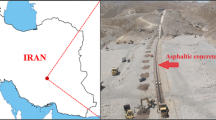Abstract
The purpose of the present paper is to view the role of theta parameters in the genesis of severe thunderstorms of pre-monsoon season over northeastern part of India. The method adopted to achieve the objective is a Hybrid soft computing system comprising of Ampliative Reasoning (AR) and Simulated Annealing (SA). The results of the study reveal a very important finding that the occurrence of such severe weather hazard requires conditional instability up to the altitude of 4.5 km. whereas convective instability persists up to 3.5 km altitude. Thus, for the genesis of severe thunderstorms of pre-monsoon season the atmosphere must have potential convective instability up to the altitude 3.5 km and the conditional instability has to persist little more.
Similar content being viewed by others
References
Abraham A, Philip NS, Joseph B (2001) Will we have a wet summer? Long term rain forecasting using Soft Computing models. In: Kerchoffs EJH, Snorek M, Eds. Modeling and Simulation 2001, Publication of the Society for Computer Simulation International, Prague, Czech Republic, pp 1044–1048
Chaudhuri S, Chattopadhyay S (2001) Measure of CINE – A relevant parameter for forecasting pre-monsoon thunderstorms over GWB. Mausam 52:679–684
Chaudhuri S, Chattopadhyay S (2002) Multilayer perceptron model in pattern recognition of surface parameters during pre-monsoon thunderstorm. Mausam 53:417–424
Chaudhuri S, Chattopadhyay S (2003) Genesis of severe local storms – a genetic algorithm approach. Sci Cult 69:331–335
Chaudhuri S, Chattopadhyay S (2004) Consequences of pre-monsoon thunderstorm – a fuzzy logic approach. Mausam 55:119–122
Chaudhuri S, Chattopadhyay S (2005a) Neuro-computing based short range prediction of some meteorological parameters during pre-monsoon season. Soft Comput 9(5):349–354
Chaudhuri S, Chattopadhyay S (2005b) Prediction of severe thunderstorm with minimal a-priori knowledge. Adv Complex Syst 8(1):1–12
Chaudhuri S (2005) Ampliative reasoning to view the prevalence of severe thunderstorms. Mausam (accepted)
Desai BN, Rao YP (1954) On the cold pools and their role in the development of Nor'westers over West Bengal and East Pakistan. Ind J Met Geophys 5:243–248
Das PM, De AC, Gangopadhyay M (1957) Movement of two Nor'westers of West Bengal – A radar study. Ind J Met Geophys 8:399–406
Gardner MW, Dorling SR (1998) Artificial neural network (multilayer perceptron) – a review of applications in atmospheric sciences. Atmos Environ 32:2627–2636
Holton JR (1992) An introduction to dynamic meteorology. Academic Press, New York, pp 291–294
Hsieh WW, Tang (2001) Artificial neural networks. Springer, Berlin, Heidelberg New York, pp 55–72
Indian Meteorological Department, 1941, ``Nor'westers of West Bengal'', Indian Meteorological Department, Tech. Note, No. 10.
James EP, Tag PM (1994) Segmentation of satellite imagery using hierarchical threshold and neural network. Amer Met Soc 33:605–616
Koteswaram P, Srinivasan V (1958) Thunderstorms over Gangetic West Bengal in the pre-monsoon season and the synoptic factors favourable for their formation. Ind J Met Geophys 9:301–312
Koteswaram P, De AC (1959) Study of pre-monsoon thunderstorms over Gangetic West Bengal by Radar. Ind J Met Geophys 10:275–282
Kalsi SR, Bhatia RC (1992) Satellite observations of development of thunderstorm complexes in weakly forced environment. Vayu Mandal 22:65–76
Klir JG, Folger TA (2000) Fuzzy sets, uncertainty and information. Prentice Hall, USA
Mull S, Mitra H, Kulshrestha SM (1963) Tropical thunderstorms and radar echoes. Ind J Met Geophys 4:269–278
Mukherjee AK, Chaudhuri AK (1979) Excessive overshooting of Cb. Ind J Met Geophys 30:485–492
Normand CWB (1938) On instability from water vapour. Quar J Royal Meteor Soc 64:47–66
Pal Sankar K, Mitra S (1999) Neuro-Fuzzy pattern recognition: methods in Soft Computing. John Wiley & Sons, New York
Ray, Peter S (1986) Meso-scale meteorology and forecasting. American Meteorological Society, Boston, USA
Ramaswamy C (1956) On the subtropical jet stream and its role in the development of large scale convection. Tellus 8:26–60
Williams E, Renno N (1993) An analysis of conditional instability of tropical atmosphere. Mon Wea Rev 121:21–36
Williams ER (1995) Handbook of atmospheric electrodynamics. CRC Press, UK
Wilks DS (1995) Statistical methods in Atmospheric Sciences. Academic Press, USA.
Author information
Authors and Affiliations
Corresponding author
Additional information
Mobile: 9830017165
Rights and permissions
About this article
Cite this article
Chaudhuri, S. A hybrid model to estimate the depth of potential convective instability during severe thunderstorms. Soft Comput 10, 643–648 (2006). https://doi.org/10.1007/s00500-005-0532-6
Published:
Issue Date:
DOI: https://doi.org/10.1007/s00500-005-0532-6




